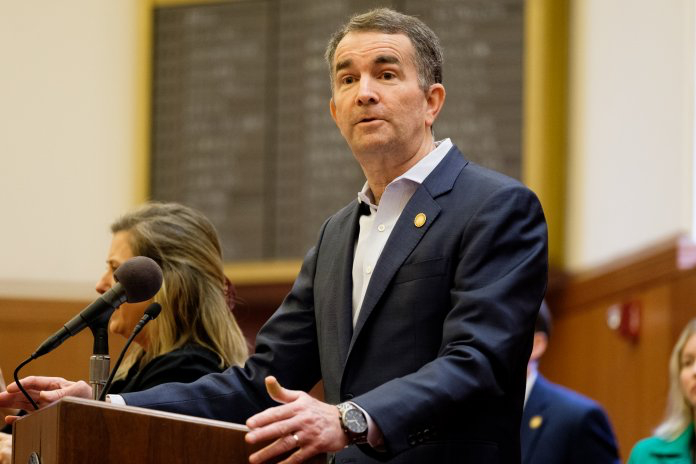Gov. Ralph Northam, pictured Tuesday, has been holding daily briefings on the spread of COVID-19 in Virginia and the state’s response. (Ned Oliver/Virginia Mercury)
By Ned Oliver
VM- With businesses around the state shutting down and cutting hours to slow the spread of COVID-19, Gov. Ralph Northam’s administration says it’s dramatically expanding the state’s unemployment insurance program to get money to more workers idled by the pandemic.
“We know rent and other bills won’t wait,” he said during a news conference this week. “If individuals are out of work because of what we’re mandating, unemployment benefits will be allowed to them.”
Thousands of workers have already signed up. The state received 4,186 applications on Tuesday and more than 5,000 as of midday Wednesday, according to Northam’s administration. That’s up from an average of about 65 claims a day last year.
Here’s what you need to know about the new eligibility rules and how Northam’s administration says it will apply them:
New rules
The program is typically limited to workers who are laid off or have their hours reduced—a category many workers affected by COVID-19-related closures already meet. But Northam’s administration says they’ve directed the Virginia Employment Commission to also approve applications that would typically be rejected from workers who are out of work because they’re:
• quarantined, either on their own initiative or at the direction of a medical official,
• caring for a family member who is ill or under quarantine,
• caring for a child whose school or day care was closed.
Northam’s administration says that they’ll err on the side of providing benefits.
“If you’re scared and quarantined for any reason, then you’re going to get unemployment insurance benefits,” said Megan Healy, Northam’s chief workforce development adviser. “If you’re young and think you (are sick and) should self-quarantine, you should be able to get unemployment benefits.”
The state is also dropping work-search requirements for affected employees, meaning workers won’t be required to visit at least two businesses a week in search of employment to maintain their eligibility.
They’ve also eliminated a one-week waiting period for benefits, during which unemployed workers are not typically paid.
The state says businesses, which pay for unemployment insurance through payroll taxes and can see their assessments go up when their former workers sign up, will not be penalized for any coronavirus-related spikes.
Who isn’t eligible
Northam’s administration is urging workers who are able to work but under quarantine to approach their employer about work from home options.
Self employed people and independent contractors, including workers for companies like Lyft and Uber, are not eligible at this point because their employers don’t pay into the unemployment trust fund, but Healy said that rule may change depending on future federal guidance.
Workers who aren’t sure if they meet the new guidelines should submit applications anyway, Healy said:
“If you kind of think you don’t qualify, just apply.”
What benefits are available and when
The state’s unemployment insurance program pays out between $60 and $378 a week for between 12 and 26 weeks.
The amount each worker receives is calculated based on their earnings over the past year. It’s complicated, but the more money you made the higher your benefits and the longer you’ll receive them. Generally, a person who earned more than $37,800 a year (about $18 an hour) would receive the maximum benefit, with people who earned less receiving less.
How fast workers begin receiving checks depends on how quickly the employment commission is able to process claims, but she said workers should expect to wait between one and two weeks.
Healy said the state is working to automate the claims process to speed the processing times.
How to apply
Workers are encouraged to submit their applications online. The state also processes applications by phone, but the system has been overwhelmed over the past two days and is not accepting calls.
Because the online application doesn’t reflect the current circumstances of many applicants, the forms can be confusing.
For instance, a Richmond woman helping a friend without a computer file her application said she was unsure whether to check a box indicating the friend is available for work — typically a requirement for an applicant to be accepted.
Her hours at a downtown Richmond hotel were cut, but with schools closing at the same time, she also wasn’t able to take on any new jobs because of sudden childcare demands.
She ultimately opted to check the box even though she wasn’t entirely sure it was accurate for fear of her claim being rejected.
Healy said such an application would be approved under the circumstances.
“We’re trying to get more and more people onto unemployment benefits,” she said.
What if it’s not enough?
At this point, the expansion of the unemployment insurance program represents the state’s primary effort to aid workers hurt by the virus.
State Secretary of Finance Aubrey Layne said it will be up to the federal government to organize any larger bailouts. The Trump administration is currently weighing a plan to send $2,000 to many Americans.
Without more help, workers worry they won’t be able to keep up with their expenses.
“I know I can pay my bills through April,” said Curtis Childres, a cook at Edo’s Squid, a restaurant in Richmond that closed indefinitely this week in response to the pandemic, prompting the entire staff to apply for unemployment on the same day.
And if he qualifies for the state’s maximum weekly benefit of $378, he says he’ll probably make it through May. But if the restaurant is still closed in June, things get bleaker.
“I would probably have to cut off my phone.”



